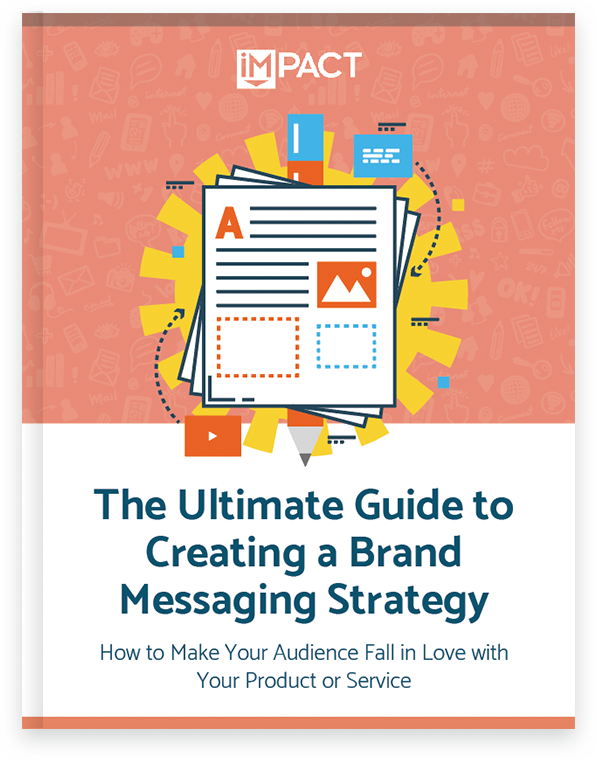
Free Comprehensive Guide
The Ultimate Guide to Creating a Brand Messaging StrategyDo you have an incredible product or service, but struggle to convey its value or differentiators? If so, you're not alone. In fact, this is the most common challenge we hear from our clients...
"The copy on my brochure is completely flat, but as soon as my star salesperson gets in front of a prospect, everything suddenly clicks! They see the value in what we have to offer, when they couldn't before!"
Sound familiar? How about these?
(That last one is a trick question -- you should be focusing more on benefits than features -- but more on that later.)
If you find yourself saying any of these, you need to sit down with your team and create a marketing messaging strategy for your brand. Luckily, that's exactly what this guide is going to teach you how to do.
Read the full guide below!
Or you can also fill out the form for a downloadable PDF version of the guide you can reference later.
Fill out the form for a downloadable PDF version of the guide you can reference later.

Before we address the "
To show you why, here's a question:
Have you ever seen little kids play soccer? (We're talking really little -- like 6 years old).
There is no structure, no precision, no strategy to their moves -- just chaos. Even the proud parents watching their enthusiastic, uniformed youngsters out on the field have to admit it pretty much just looks like a bunch of children running around in an area that happens to house a soccer ball and goals.
Now, let’s contrast that with watching pros play soccer.
Watching pros is like watching gears in a finely tuned machine working in perfect harmony. All of the players are in-sync. They all work from the same playbook and each knows what the other is doing, or planning on doing next.
Similarly, if everyone in your organization is following the same playbook when it comes to marketing messaging, it will make a world of difference in your ability to win new business.
There will be continuity between different mediums or between different authors. The journey will flow seamlessly from marketing and sales, to customer service and delivery. Prospects will be able to easily see what key benefits they will get and how your product or service fits right in to relieve their pains.
A thoughtful messaging strategy will highlight your key differentiators (reasons why prospects should pick you over the competition), value propositions (what you can do for them), and detailed marketing messages you should use to win over your individual buyer personas.
In addition to making your product or service irresistible to prospective buyers, you'll see the following benefits within your own organization with the right messaging strategy in place:
The best way to create a solid brand strategy and messaging framework
Gather all those smart people in one room for a messaging workshop and try to pull information out of their brains -- your ingredients. You’ll want to make sure you’ve included sales leadership, executives or company owners, and product or service delivery leads. Basically, you want anyone who considers the company or the product it produces “their baby.”

They should be able to talk at length about the offering, and
Combine, refine, and distill that information into the first draft of a messaging matrix. (Don’t worry! We’ll show you what that looks like later!) From there, you’ll feed it back to the smart people and let them poke holes in it -- taste-testing.
Once you’ve gathered all the feedback, you can revise and perfect that strategy into a finished product -- a new dish for your menu.
Step 1:

In our messaging workshops, the first place we always start is with brand strategy.
There are four major types of brand strategies companies can follow.
In this style, your goal is to outsmart the market leader and beat them on their home turf. This works well where the market category is established, but there are a lot of players involved with no clear leader that's way ahead of the competition.
The classic example is Coke vs. Pepsi.
The two rival soda giants are very much alike. As a result, they're always neck-and-neck, competing for the most market share.
Your target buyers already has a frame of reference, so it's not a big leap for them to get what you're offering to them. “Oh, I get it, what you're selling is like X.”
Do you have a lot of time and money? Good. That's what you're going to need to win with this strategy.
With this style, you want to focus on a small segment of an already existing market. For instance, you might create a niche for yourself, in order to cater to an underserved audience. This is particularly handy if there's a clear segment of the existing market, and the existing champion in that space is failing to address their specific needs.

Many marketing agencies, for example, adopt this strategy and market themselves as a specialist in providing services to a specific industry with unique needs. For instance, an IT consulting firm that only works with law firms.
Again, your audience gets your product, because it's close to what's already out there for sale. On top of that, you're no longer trying to compete with the top dog in that general market category, since you're now trying to cater to a niche audience.
Here's the thing, though. That market leader could decide one day that they don't like you running off with that niche segment of the audience, so they start offering the same specialized services.
This style is simple. You take a market that already exists and redefine it in new terms. More specifically, you render the benefits previously highlighted by market leaders moot. Instead, your product or service is so innovative and advanced in a way unheard of before. Or, maybe the market itself has changed, in either needs or expectations.
Tesla and Apple made their killing by reframing the market.
Think about it. In the beginning, electric cars competed on a single feature -- the life of the battery. Then, Tesla walked through the proverbial doors and said, "Pfft! Battery life? Please. That should be assumed. Instead, we're going to talk about style. And experience. And what it means to drive a Tesla."
Tesla shifted the conversation and changed the game forever.
Apple did the same thing.
"Computers should always have enough storage and boast high-speed performance. Who cares? With our products, it's about style. Our products are not only functional and top-of-the-line; they're works of art. They're a status symbol."
In this category, what makes you different are your strengths. Not only that, they're irresistible to your audience, so they make the market leader yesterday's news.
Much like the big fish, small pond scenario, it's not always a great idea to rile up the market leader. They may wake up one morning and say, "That feature that makes our competition so different to our customers? Yeah, let's do that. Let's offer the same thing."
You need to be very careful if you're considering this strategy. If there's a market category already for what you do, it won't work. You have to be the first.
If you look around and see that you are -- and your strengths don't fit in other categories -- congratulations! You get to invent your own category.
And we all know Uber changed the game.
That's because, before Uber, there was no such thing as a rideshare app. They literally invented it. And if you want to know if you've been successful with this strategy, wait to hear something like, "Man, they're the Uber of food delivery."
You got to the top of the mountain first. You are the leader.
Not every idea is a good idea. So, ask yourself, "Is there really a need for my product or service?" Sometimes the reason a category doesn't exist is because it's not needed.
And if you don't believe us, let's take a trip down memory lane, because history is littered with “innovative” product flops:
The other risk is that you need to get a head start with your strategy, because copy-cats will not be far behind. You have to establish yourself as the leader before someone else sees your great idea and then gets to the finish line faster.
And then you're the copy-cat.
Brands are always talking about how to differentiate themselves from competitors. But first, we need to talk about differentiation vs. disruption. The term “disruptor” is thrown around a lot, especially in the startup world. The idea behind it is that disruptors come in and “shake up” the market.
We want to encourage you to not think that way.
Peter Thiel says it best in his book Zero to One:
“You don’t want to be a disruptor, you want to be a leader.”
In grade school the term “disruptor” had a negative connotation. It was reserved for students who caused problems in class. As a business, the term should be no different.
Labeling yourself as a disruptor will only push others to think about how you compare to direct competitors, and highlight nitpick-y differences between you and those you are up against. Think instead about how you can be a leader and talk about what makes you amazing and unique instead of just what makes you different than that guy over there.
If you think like a disrupter, you’ll end up looking like a game of Where’s Waldo.

You and your competitors all the look the same, and someone would be hard-pressed to pick you out of the crowd. If you think like a leader, you’ll end up standing where there is no crowd, and people find you with little effort at all.
This is how you should select your differentiators:
This is where the magic happens.
Step 2:

We’ve talked at length on the IMPACT blog about buyer personas, so we won’t rehash it here. We’ll just say that you must have your buyer personas in place before you do anything else.
Here are a few of our existing resources to help:
We also have a free buyer persona toolkit for inbound marketers that you can use to create your own.
Now comes our favorite part: breaking down decision-making styles. This is where the puzzle pieces start to come together.
There are four primary types of personalities, and each of them
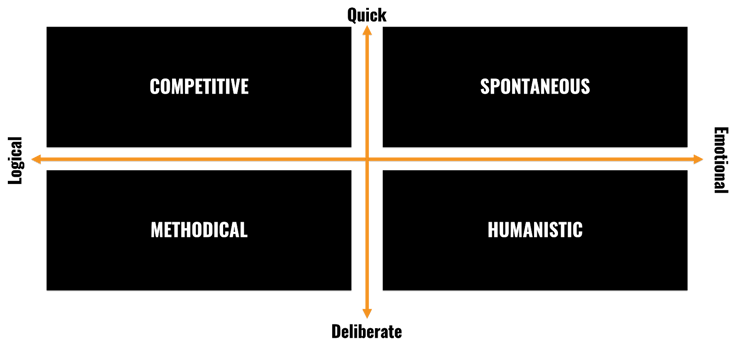
People make decisions across two different spectrums.
Looking at the diagram above, you can see on the X-axis is the spectrum between logical (heavily fact-based) and emotional (heavily feeling-based) decision-making. On the Y-axis is the spectrum between quick (makes decisions very quickly) and deliberate (makes decisions very slowly) decision-making.
Using the information below, assign a primary decision-making style to each of your personas.

Individuals who fall in the top left quadrant tend to make decisions more quickly and make them based on facts and logic. This decision-making style aligns with Dominant DiSC personality type.

Individuals who fall in the top right quadrant tend to make decisions quickly but make them based on “gut feeling” and intuition rather than facts or numbers. This decision-making style aligns with Influencer DiSC personality type.

Individuals who fall in the bottom left quadrant tend to make decisions very slowly and only make them based on facts gained through rigorous research. This decision-making style aligns with Conscientious DISC personality type.

Individuals who fall in the bottom right quadrant make slower decisions and tend to base those decisions on how they think the outcome of that decision will make themselves or others feel. This decision-making style aligns with Steady DISC personality type.
Just like with DISC personality types, it is entirely possible to have a hybrid between two decision-making styles, but one style should stick out as the primary. Try to associate only one decision-making type to each of your personas. More than that will start to get confusing.
Step 3:

Now that you know how each of your personas make decisions, you can begin to formulate your ideas around how you’ll message to each of those personas. Use the guidelines below to tailor your value propositions and key messages toward each individual.
The Competitive wants to know what you can do for them, not how you do it. And they want you to tell them quickly and simply. They also want a clear understanding of the options in front of them and why you are the best choice.
The Spontaneous loves being a part of the “in-crowd.” They want to know who’s used your service and why. For them, the focus is on the enjoyment of life.
Speaking to the Methodical is where you can break the rules about discussing how your product works. They really do care and want to know every detail, so provide it to them early in the buying process.
 The Humanistic is all about people and relationships. They want to know who they are working with and are very interested in the relationships that will accompany the use of your product or service.
The Humanistic is all about people and relationships. They want to know who they are working with and are very interested in the relationships that will accompany the use of your product or service.
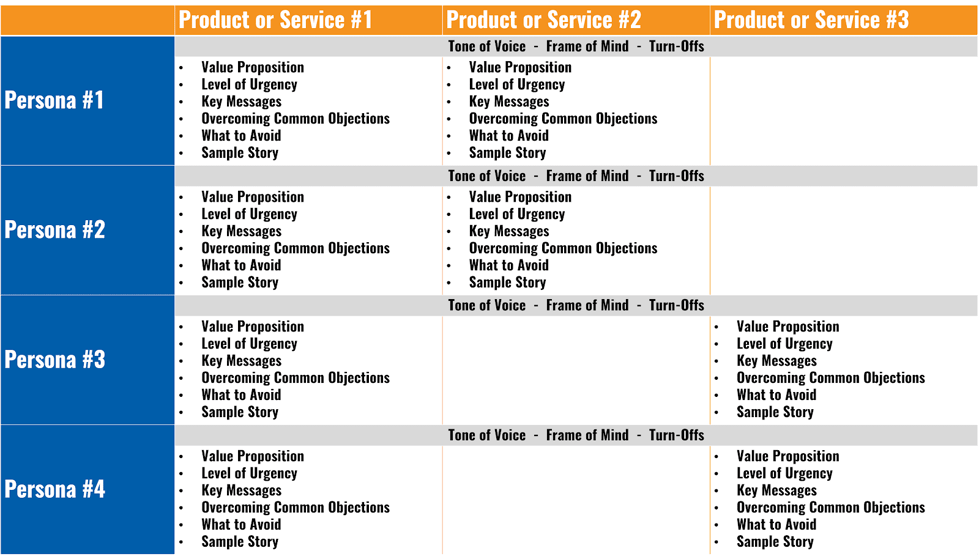
Sample Messaging Matrix
Before you move on from step 3, and onto steps 4, 5, and 6, you will need to put together a messaging matrix to fill in. You will use this matrix to document the key messages you’ve identified in this section, as well as what follows in the remainder of this process.
The example above is one that we use to draft our messaging strategies for clients, but yours could look different. However, a successful messaging matrix must include your personas, and your product and services, as well as space, to define each of the following:
In any case where a specific product or service offering would apply to a specific persona, the messaging strategy for that persona should be entered into that cell.
Here's an example of how you might flesh out the details for a particular persona:
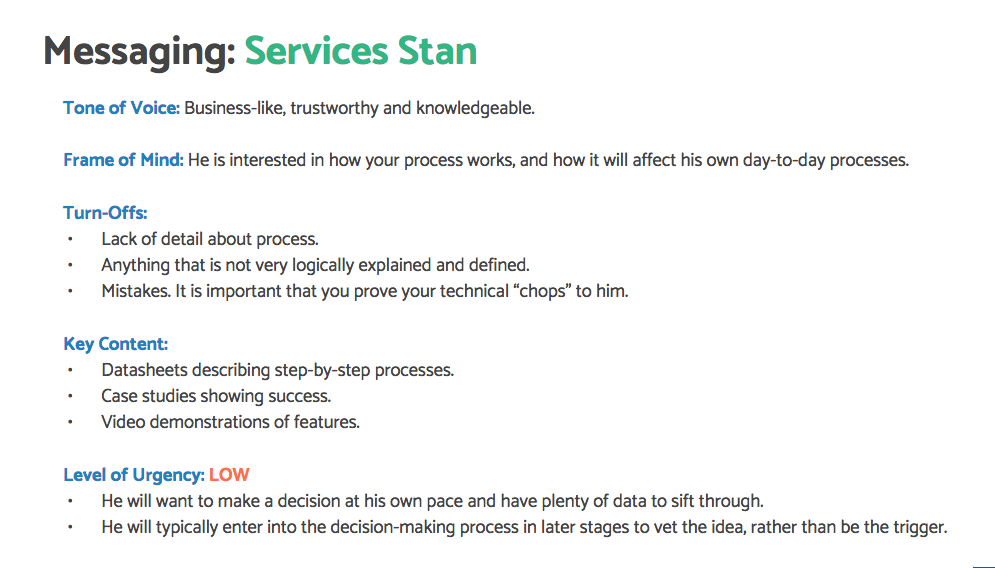
(We'll show you an example of the key messages and sample story sections later.)
Step 4:

Now that you have personas created and a decision-making style assigned to each, it is time start the real work -- writing value propositions! You’ll want to write a separate value proposition for each product or service line for each persona that would purchase that product or service.
A value proposition is a single sentence about your product or service that distills down the benefit it provides to the end user.
A good value proposition should try to answer all of the following questions:
Notice we don’t have “How does your product or service work?” in the list above. Your value proposition should not be about how your offering works, but should ultimately focus on the benefits your product or service provides.
A great starting point is to use the following template:
[My firm] is the only [noun, competitive category] that provides [plural noun, your target audience] with [plural noun, emotional benefit] by/through/with [adjective, your unique differentiator].
We wouldn’t recommend leaving it in that format grammatically, because that isn’t how people really talk. But, if you write it in that format first, it can help get your ideas on paper. Then you can rephrase it into a more conversational structure.
Step 5:

Up next, you’ll want to select key messages for each of your personas and products. You should have no more than four or five key messages for each cell in your messaging matrix. These points should be the benefits provided by your product or service that this specific persona will identify with.
Here's what a fully-developed example of key messages and a sample story might look like:
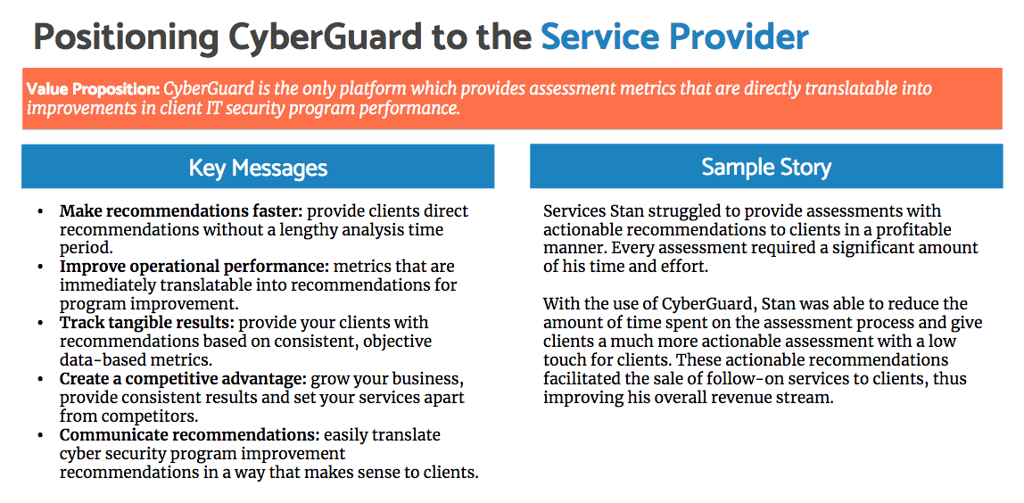
One great example of this is Domo, where they have pages on their site dedicated to outlining the value propositions for specific personas:
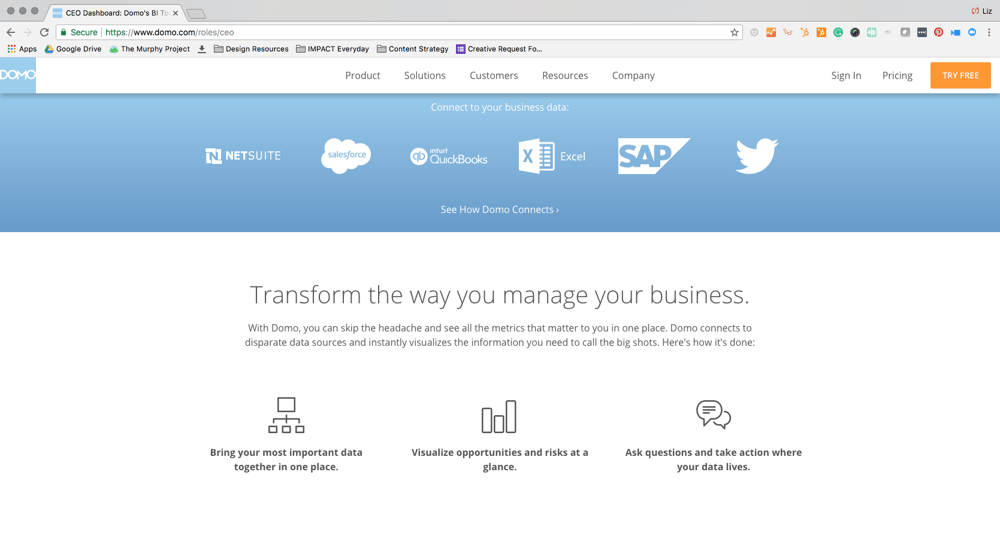
You'll see in the address bar that this is a page designed only for CEOs. It highlights the three key benefits that come from their product for the CEO, based on their goals and challenges. This is how you should approach the creation of your key messages.
Step 6

It is our firm opinion that no messaging strategy can be created in a vacuum. You can’t do it alone. One person will never be able to create a great messaging strategy. You’ll want the ability to bounce ideas back and forth and test them out.
Personally, we don’t think any company can really do a good job of creating a messaging strategy by themselves. It truly takes an objective, outside party who is willing to push back. The core team from inside the business will be too “in the weeds” to really see things from an outsider perspective. So, keep that in mind if you’re trying to do this internally.
Once you have written a messaging framework, consider it just a first draft, a “proposal” of sorts. Take it back to the same team who helped you brainstorm and let them poke holes in it, make minor tweaks and perfect it.


The messaging strategy you create at the close of this exercise using your matrix should be treated like gold. It truly is one of the most important documents for your company’s success. Think of it like your business’ North Star or Guiding Light. Everyone in the company should know it like the back of their hand and be comfortable speaking with outsiders about the products and services your company offers.
But once you have the framework in-hand, what should you do next?
Well, the answer to that depends on what your immediate needs and goals as a business are, but here are a few suggestions:
Update Your Website Copy
Are the messages currently on your website in-line with what your personas need to hear based on your newly-defined decision-making styles and preferences?
Revise Your Marketing Collateral
Are your brochures and handouts targeting the right message for the right people?
Refine Sales Scripts & Templates
What messaging changes can you make to your sales tools that will have an immediate impact?
Update Your Employee Onboarding
Are there opportunities to introduce these new insights early, as part of training for new marketing, sales, and customer service team members?
And so much more.
But remember, your marketing messaging framework is not a “set it and forget it” strategy. Businesses pivot, products change, and target markets evolve. Revisit your messaging regularly -- maybe on a quarterly or annual basis.
Now, we release you! Go forth and message wisely!
Learn how we can help you reach your goals -- and to see if we're the right fit for you.
Talk to us